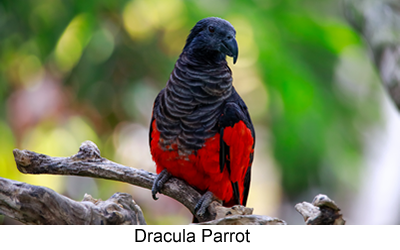 |
|
|
Animal
of the Month
|
March
2021
|
Name:
Dracula Parrot (a.k.a. Pesquet's Parrot) Classification:
Class: Aves
Order: Psittaciformes
Family: Psittacuiidae
Subfamily:
Lutrinae
Genus: Psittrichas
Species: P.
fulgidus
Size: 18 inches
long Thick plumage on chest, long head with curved beak, partially bald head with one eye on each side of the head, pink fleshy tongue, two legs and grasping feet with three claws each. Color(s): Dark gray on the head, back and tail, gray and red on the body and wings. Most males have red spots behind the eyes. Behavior: Seasonably nomadic, lives in pairs or groups. Preferred Habitat: Cloud forests and hills. Range: Hill and montane rainforests of New Guinea. Diet: Mostly figs, sometimes flowers and nectar. Lifespan: Not available. Status: Vulnerable There is a vampire lurking in the forests and hills of New Guinea. It flies through the jungle by day, making unsettling screeching sounds. It is clothed in red and gray feathers and feasts mercilessly on figs…OK, it's not really a vampire. But if you really want to meet a vampire, the closest you may get is the Dracula parrot! Dracula parrots are named so because of their eerie appearance. They have spooky dark gray and red feathers, black beaks, and bald vulture-like heads. As if that wasn't enough, they also make freakish screeching sounds! Despite their creepy looks and behavior, Dracula parrots are not like vampires at all. They're not even aggressive, though they might bite if they feel threatened. They eat almost exclusively several varieties of figs as well as flowers and nectar. Some scientists think that they have bald heads so that things are less messy when they eat sticky fruit. When travelling through the rainforest, Dracula parrots are often found in pairs, or in groups up to twenty. In the air, they alternate between flapping their wings and gliding for short distances. They are also known for jumping from branch-to-branch rather than flying to different branches. Dracula parrots live a semi-nomadic lifestyle, moving to different places depending on when figs are available. Not much is known about the breeding habits of Dracula parrots. What we do know is that they lay two eggs in a hollow tree. Dracula Parrots are classed as vulnerable. Its estimated there are between twenty and forty-nine thousand birds in the wild, but those numbers are decreasing. The main threat Dracula parrots face is deforestation due to logging, mining and human expansion. Another major problem is the animal trade. Their feathers are in high demand and the birds themselves are sought after for exotic pets. There do not appear to be many active programs dedicated solely to the Dracula parrot. The good news is that a lot is being done to protect the habitat of the Dracula parrot. The World Wildlife Fund has done extensive work to preserve the rainforests of New Guinea. The New Guinea Binatang Research Center also is working hard to conduct research, provide education, and promote responsible forest management. These conservation efforts help to protect the Dracula parrot and thousands of other species with which they share the rainforests. There is no easy solution, but with dedication and awareness, the Dracula parrot will be able to haunt the forests for generations. To learn more about how to help this spooky bird and their forest home, follow these awesome links! World Wildlife Fund,
New Guina Page-Check out what the WWF is doing for New Guinea's rainforests! New Guinea Binatang
Research Center-Protecting the forests of New Guinea through education,
stewardship and research! You can also be a HUGE
help to Dracula Parrots if you… |
|
|
|
|
|
|
||
|
Contact
Us
|
||||
|
Taproot
Guru © ALL RIGHTS RESERVED
|
||||